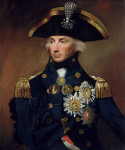 One of England’s greatest heroes, Admiral Lord Horatio Nelson was responsible for numerous naval victories during the Napoleonic Wars, wounded several times, and finally killed during the Battle of Trafalgar in 1805.
One of England’s greatest heroes, Admiral Lord Horatio Nelson was responsible for numerous naval victories during the Napoleonic Wars, wounded several times, and finally killed during the Battle of Trafalgar in 1805.
I have attempted to find as many descendants as possible of Nelson, his parents and grandparents. However, this is a large family, and there are some gaps. If you find anything missing, please do let me know.
(By the way – if you’d like to learn how to trace your ancestors – have a look at my step-by-step beginner’s course)
Horatio Nelson was born at Burnham Thorpe, Norfolk on September 29th 1758, the son of the Reverend Edmund Nelson and his wife Catherine Nelson (nee Suckling). His grandfather was also Edmund Nelson, the son of William, the son of another Edmund, all clergymen. At this point the line gets a little dodgy. It is thought that this Edmund was born in about 1610, the son of a Thomas and Elizabeth, and the line may go back to 16th century London and 15th century Lancashire, but I have been unable to substantiate these earlier records.
If you are a descendant of Nelson (the only living descendants will be via his illegitimate daughter, Horatia), you are likely to already know about it as the name Nelson was carried though the generations in well documented families.
If you are wondering whether you are connected to Nelson via a less well known family link, then you will need to scroll down to see details of his siblings and his parents’ siblings.
If you are tracing your Nelson family name in Norfolk, great care needs to be taken, as there are several families with this name, so you should not assume a close link with the Admiral unless you can prove it without doubt using original sources
Descendants of Nelson
(Surnames that may have living descendants: WARD, SOMERSET, WEEKES, and JOHNSON)
Nelson married Frances Herbert WOOLWARD, the daughter of William WOOLWARD in 1787 at Montpelier in St. Nevis, but the marriage produced no surviving issue.
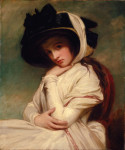 However, Nelson’s famous ongoing affair with Emma Hamilton (nee LYON) did produce a daughter, from whom there were descendants. This child was Horatia Nelson, and she married the Reverend Philip WARD in 1822. The WARD family is as follows:
However, Nelson’s famous ongoing affair with Emma Hamilton (nee LYON) did produce a daughter, from whom there were descendants. This child was Horatia Nelson, and she married the Reverend Philip WARD in 1822. The WARD family is as follows:
Horatio Nelson WARD. Married Elizabeth Martha BLANDY in 1856 in Tooting, Surrey. Their children were:
Elizabeth Horatia Anne NELSON-WARD – Married Raglan Turberville Henry SOMERSET and had issue.
Horatio Nelson NELSON-WARD – No marriage.
Marmaduke Philip Blandy NELSON-WARD – No marriage found.
Hugh Herbert Edward NELSON-WARD – No marriage found
Admiral Philip NELSON-WARD – Married Hon. Dorothy CAULFIELD. No issue.
Rupert William NELSON-WARD – Died in infancy.
Eleanor Philippa WARD – did not marry. Died in 1872
Marmaduke Philip Smyth WARD – No marriage
John James Stephen WARD (died in childhood)
Nelson WARD – Married Jessie WARD. Their children were:
Nelson WARD – No marriage
Rose Nelson WARD – No marriage
Florence Nelson WARD – No marriage
Jessie Nelson WARD – Married Arthur WEEKES in 1888 and had issue in India and England.
Mary WARD – No marriage found
Kathleen Nelson WARD – No marriage
Agnes WARD – No marriage found
Maurice Suckling WARD – No marriage found
William George WARD – Married Toriana BLANCKLEY. Not sure if there was issue – please let me know if you have further information.
ADDENDUM – (Added 14th September 2016) – a descendant of William George Ward has very kindly emailed me with the following information:
“Lieutenant Colonel William George Ward married Catherine Parker Toriana Blanckley (the only daughter of Captain Edward Blanckley RN and Harriet Matcham, Lord Nelson’s niece) on 15 Nov 1864 •Clevedon, Somerset, England.
They had six daughters (great-granddaughters of Nelson & Emma Hamilton and Nelson’s sister, Catherine and George Matcham). Their first five daughters were born in India, where William Ward was stationed. The first five daughters were:
Ellen Catherine Ward 1865 – 1938
Ethel Mary Ward 1866 – 1946
Caroline Gertrude Ward 1868 – 1941
Evelyn Hervey Ward 1870 – 1961
Ada Blanche Ward 1871 – 1911
Their sixth daughter was born in Pinner, Middlesex in a house near William’s mother, Horatia. She was:
Alice Lilian Ward 1873 – 1911
William Ward died in Hastings on 10 Au 1878.
My 2nd great-grandmother, Tori, took her six daughters to live in Lutton House, a country house her father, Edward Blanckley had built near the village of South Brent in Dartmoor, Devon.
Of these six sisters, the only one to marry was the youngest, Alice. She married the village doctor, Frederick William Style on 24 Jun 1903 (please see attached Exeter and Plymouth Gazette announcement).
Alice and Dr Frederick Style had two children:
Professor Derrick William Style 1904 – 1979
Phyllis Horatia Style 1907 – 1987
Phyllis remained a spinster, but my grandfather, Derrick married:
1) Lilian Langford (1903 – 1946) in Sept 1940 in Westminster. They had one child: my mother, Ray Vanda Style (1942 – still living)
2) Hilde Frönwiesser (1918 – 1967) in Dec 1946 in Paddington. They had one child, Eric Frank Style (1948 – 1964)
3) Mary Whittaker (1923 – 2013) in Sep 1969 in Wandsworth, Surrey. They had no issue.”
(If anyone would like to see the copy of the marriage announcement in the Exeter & Plymouth Gazette, please email me at info@tracingancestors-uk.com).
Edmund Nelson WARD (died in infancy)
Horatia WARD – Married William JOHNSON in 1858. Their children were:
William Horatio JOHNSON – Married Mary Tress CURTEIS and had issue (Kent)
Margaret JOHNSON – No marriage found as far as I know.
Philip WARD – No marriage found
Caroline Mary WARD – No marriage.
Nelson’s Paternal Family – Surnames include NELSON, BLAND, ROLFE, GOULTY, HOOD, ROCHFORT, LAW, COOK, WILLIAMS, STILWELL, SHIRLEY, PURVIS, BENDYSHE, WALDY, CROWTHER, MASON, BOLTON, GIRDLESTONE and possibly the name CLAGUE and BUSSELL.
Nelson’s grandfather was Edmund NELSON. He was married to Mary BLAND (see below), and his other children were:
Thomas Bland NELSON (1719). No marriage found.
Martha NELSON (1726) Died in childhood.
Alice Bland NELSON (1730). Married Robert ROLFE. Their children were:
Ellen ROLFE(1761), Edmund ROLFE(1763) and Robert ROLFE (1767). If you can find links to these children you can claim to be a cousin of Nelson.
Thomasin NELSON (1732). Married John GOULTY. Their children (all born in Norwich) were:
Edmund GOULTY (1758) – No marriage found
Thomasin GOULTY (1759) – No marriage found.
William GOULTY (1763) – Married a Sarah WALLIS in 1785. Anyone tracing lineage back to this couple could claim to be cousins of Nelson.
John NELSON (1736). Possibly married Mary INANS in Hingham, 1758 – though needs further evidence.
Mary NELSON (date unknown). Several possible marriages – needs further research.
Nelson’s father Edmund married Catherine SUCKLING (see below). Nelson’s siblings were:
Maurice NELSON (1753). No marriage.
William NELSON (1757) – Married Sarah YONGE. Their children were:
Charlotte Mary NELSON – Married Samuel HOOD, 2nd Baron Bridport, in Marylebone in 1810, and became Duchess of Bronte. Her children were:
Frances Caroline HOOD – Married Sir John WALROND MP. Their children were:
William Hood WALROND (1st Baron Waleran) (1849)
Arthur Melville Hood WALROND.
Charlotte WALROND – Married Horace ROCHFORT in 1845 (probably in Ireland) and their children were:
Amy ROCHFORT – married Thomas P LAW and their living descendants may be found in Ireland and possibly in Northumberland.
William ROCHFORT – No information available.
Alexander Nelson ROCHFORT (Major General) – Did not marry.
Henry ROCHFORT – No information available.
Alexander ROCHFORT – married Mary Penelope, Viscount Bridport and they had the following children:
Mary ROCHFORT – No information at present.
Harriet ROCHFORT– No information found
Jane Sarah ROCHFORT – married Sir Charles HOTHAM KCB but there was no issue.
Arthur Wellington Alexander Nelson HOOD, 2nd Viscount Bridport – married Lady Maria Georgiana Julia Fox-Strangways and their descendants should be found in the London area. I do know that their daughter, Mary Nelson HOOD, married married Sir Herbert Frederick COOK, 3rd Baronet, and became Marchioness of Hertford. Their son was the artist, Sir Francis Ferdinand Maurice Cook, 4th Baronet, who married 7 times, with children still living.
Suckling NELSON (1764) Died without issue.
Edmund NELSON (1764). Died 1799 without issue.
Catherine NELSON – married George MATCHAM. Their children are as follows:
George MATCHAM – married Harriet EYRE in 1817. Their children were:
Horatio Nelson Eyre MATCHAM (died without issue)
Catherine Eyre MATCHAM – married Henry Blackstone WILLIAMS. They had 10 children and descendants will originate in Wiltshire and Dorset, and will include the surnames STILWELL and SHIRLEY.
George Simon Eyre MATCHAM (died young)
William Eyre MATCHAM – married Mary Elizabeth LONG. Their descendants can be found in Wiltshire and Oxfordshire.
Louisa Harriet Eyre MATCHAM – married Fortescue Richard PURVIS. Their descendants may be found in Essex, Hampshire, Shropshire and Wiltshire.
Henry Savage MATCHAM – I have no further information about him.
Catherine Anne MATCHAM – married John BENDYSHE and their children were:
John BENDYSHE (died without issue)
Richard BENDYSHE (died without issue)
Nelson BENDYSHE – married Charlotte BRODRICK. Their descendants may be found in Australia and Devon.
Caroline BENDYSHE – married John GIBSON (not sure if they had children)
Laura BENDYSHE – married Charles Richard William WALDY and their descendants may be found in Surrey and Essex.
Thomas BENDYSHE – no issue
Susannah BENDYSHE – married William CROWTHER Their children were born in Worcestershire.
Edward Nelson MATCHAM – I have no further information.
Elizabeth MATCHAM – I cannot find a definite marriage or death for her.
Francis Griffith MATCHAM – Died in 1808.
Horatio Nelson MATCHAM – Died in 1821 without issue.
Nelson MATCHAM – Did not marry. Died 1886.
Horatia MATCHAM – She married Henry William MASON. Their children were:
Mary Eliza MASON – no marriage or children
George Nelson Pomeroy MASON – married Marian ROUSE. Their children were born in Kent.
Susan MASON – I have no further information.
Horatia Nelson MASON – no marriage or children
Charlotte MASON – No further information
Augusta P MASON – No further information – probably did not marry.
Anne L MASON – no marriage or children
Frank MATCHAM – no further information
Harriet MATCHAM – No further information.
Anne NELSON – Possibly marriage William CLAGUE – but I have found no evidence. Please let me know if you have further information about this. (Added 04/01/2019 – See note in Comments below)
Susannah NELSON – married Thomas BOLTON. Descendants of this line also have the name NELSON, as their son Thomas took on the famous surname (see below). Their children were:
Catharine BOLTON – Did not marry, no issue.
Jemima Susanna BOLTON – Did not marry, no issue. Died 1864.
Anne Nelson BOLTON – As far as I know, she did not marry, and died in 1830.
Thomas BOLTON (NELSON) Esq. (later 2nd Earl Nelson) – Married Frances Elizabeth EYRE, and their children were:
Horatio NELSON (3rd Earl Nelson) – Married Lady Mary Jane Diana AGAR. Their children were born in Wiltshire. Their son Herbert was the Viscount Trafalgar.
Rev. John Horatio NELSON – Married Susan Spencer-Churchill. Their two children were born in Scottow, Norfolk.
Frances Catherine NELSON – Married Robert John BUSSELL – I have found no children for them and have no further information.
Susannah NELSON – Married Alexander Calvin BLUNT – but there seems to be no issue from this marriage.
Maurice Horatio NELSON – Married Emily BURRARD. Their children were born in Hampshire and Wiltshire.
Edward Foyle NELSON – Died young in 1859 without issue.
Henry NELSON – Died young in 1863.
Elizabeth Anne BOLTON – Married the Rev. Henry GIRDLESTONE. Their children, all bon in Earlham, Norfolk, were:
Henry GIRDLESTONE – Married (1) Caroline Warren PIGOT and (2) Eliza MASON. He emigrated to Australia in 1872, and their children were born in Queensland.
Elizabeth Ann GIRDLESTONE – Did not marry, no issue.
Horatio GIRDLESTONE – Married Ellen Catherine BOLTON. Their children were all born in Norfolk.
Charles GIRDLESTONE – Probably unmarried.
Nelson GIRDLESTONE – Married Caroline Warner (surname unknown) – probably in Nova Scotia. Their children were born in Norfolk, Gloucestershire and London.
Maurice Nelson GIRDLESTONE – Married Katherine Alice LINKLATER. They had just one son, Arthur Nelson, born in Streatham Hill, London.
Susanna Catharine GIRDLESTONE – no further information.
Eliza Nelson BOLTON – No further information.
George BOLTON – Died at sea in 1799. No issue.
Susannah BOLTON – Did not marry, no issue.
BLAND
Nelson’s paternal grandmother was Mary BLAND, the daughter of John (a baker) and Thomasin, born in 1698 in Cambridge. Her siblings may have been Thomazin (1706), Alice (1708) and Thomas (1711), though there may have been more, and they were probably non-conformists. If you have BLAND ancestors going back to these dates in Cambridge, then you may be able to find a connection.
Nelson’s Maternal Family – Surnames include SUCKLING, TURNER, WODEHOUSE and WALPOLE
SUCKLING
Nelson’s mother, Catherine Suckling, was the daughter of the Reverend Maurice Suckling and Mary Ann TURNER, and the sister of Captain Maurice Suckling who became Comptroller of the Navy in 1775. He was married to his cousin, Mary Walpole, the daughter of Robert Walpole, Earl of Oxford, but she died in 1766 and they had no children.
The only other sibling of Catherine’s who may have survived, was William, but I can find no marriage for him. There are therefore no descendants from Catherine’s generation. However, the father, Maurice had at least 13 siblings, most of whom seem to have survived to adulthood, so there may well be Suckling families who could be traced back to the parents, Robert Suckling and Ann WODEHOUSE of Norfolk in the late 17th and early 18th centuries.
TURNER
Nelson’s maternal grandmother was Mary Ann TURNER, the daughter of Sir Charles TURNER, 1st Bt., and Mary WALPOLE. Her only sibling was John TURNER, who died without issue. There does not seem to be much information about Charles’s parentage, but possibly if you can trace a TURNER line to Norfolk of the late 17th century you may have a chance of finding a connection there.
If you think you may have connections to Nelson’s tree and would like some professional help, please view my services on my Services Page before contacting me.
Save
Save
Save
Save
Save
Would you like to learn how to trace your ancestors? Have a look at my Step-by-Step Beginner’s Course.
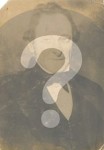 We probably all have one. And I don’t mean an ancestor who drank too much (though we probably all have a few of those too!). What I mean is an ancestor who you are around 70-90% sure is your ancestor, but you do not have that crucial record to make it 100% certain. Perhaps there is a person where you have been unable to find a baptism, but there is a couple of the right child-bearing age in that parish who you think are ‘probably’ the parents. Do you carry on and trace those parents, or do you leave it there?
We probably all have one. And I don’t mean an ancestor who drank too much (though we probably all have a few of those too!). What I mean is an ancestor who you are around 70-90% sure is your ancestor, but you do not have that crucial record to make it 100% certain. Perhaps there is a person where you have been unable to find a baptism, but there is a couple of the right child-bearing age in that parish who you think are ‘probably’ the parents. Do you carry on and trace those parents, or do you leave it there?



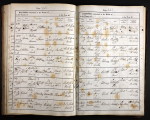 my honest answer would be: Yes, at the beginning, but in the long run, no. As you build your family tree you will find that if you wish to make a thorough and accurate job of tracing your ancestry, there will be necessary expenses (e.g. ordering birth or marriage certificates), and some expenses that may not be necessary, but will make the process a lot easier (e.g. family tree software).
my honest answer would be: Yes, at the beginning, but in the long run, no. As you build your family tree you will find that if you wish to make a thorough and accurate job of tracing your ancestry, there will be necessary expenses (e.g. ordering birth or marriage certificates), and some expenses that may not be necessary, but will make the process a lot easier (e.g. family tree software).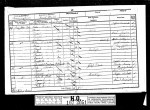 A full census and BMD research website – but you will need to pay a subscription depending on your requirements, and whether you want to pay monthly, quarterly, 6 monthly or yearly.
A full census and BMD research website – but you will need to pay a subscription depending on your requirements, and whether you want to pay monthly, quarterly, 6 monthly or yearly. One of England’s greatest heroes, Admiral Lord Horatio Nelson was responsible for numerous naval victories during the Napoleonic Wars, wounded several times, and finally killed during the Battle of Trafalgar in 1805.
One of England’s greatest heroes, Admiral Lord Horatio Nelson was responsible for numerous naval victories during the Napoleonic Wars, wounded several times, and finally killed during the Battle of Trafalgar in 1805. However, Nelson’s famous ongoing affair with Emma Hamilton (nee LYON) did produce a daughter, from whom there were descendants. This child was Horatia Nelson, and she married the Reverend Philip WARD in 1822. The WARD family is as follows:
However, Nelson’s famous ongoing affair with Emma Hamilton (nee LYON) did produce a daughter, from whom there were descendants. This child was Horatia Nelson, and she married the Reverend Philip WARD in 1822. The WARD family is as follows: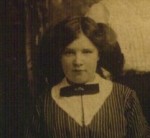 This is the last in my series of blog posts about my grandmother and her six sisters. This one is about the youngest, but perhaps most enterprising of the seven girls.
This is the last in my series of blog posts about my grandmother and her six sisters. This one is about the youngest, but perhaps most enterprising of the seven girls. We have an interesting photograph of Dorothy, with her oldest sister Maude, shown here. Maude (in foreground) is pointing at a photograph. I have looked at this with a magnifying glass, and although it is difficult to see, I believe it is a picture of that dinner service. It may be that Maude had helped her with the task. The two sisters look proud, and it is my theory that they look out at us from their early 20th century viewpoint, and say ‘Look at us. We are women, and see what we can achieve.’
We have an interesting photograph of Dorothy, with her oldest sister Maude, shown here. Maude (in foreground) is pointing at a photograph. I have looked at this with a magnifying glass, and although it is difficult to see, I believe it is a picture of that dinner service. It may be that Maude had helped her with the task. The two sisters look proud, and it is my theory that they look out at us from their early 20th century viewpoint, and say ‘Look at us. We are women, and see what we can achieve.’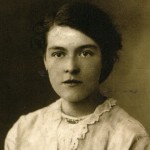 In my series looking at my female ancestors and their experiences of World War I, we have now come to my own maternal grandmother, Elizabeth Reid. Obviously I knew a bit more about her before I began my research. She was born on 28th December 1892 at Harpurhey, like her sisters, and baptized the following February. They were living at 222 Conran Street, a rather bleak looking side-street these days which looks as though most of it has been cut off and re-built so I have no idea what the house might have looked like.
In my series looking at my female ancestors and their experiences of World War I, we have now come to my own maternal grandmother, Elizabeth Reid. Obviously I knew a bit more about her before I began my research. She was born on 28th December 1892 at Harpurhey, like her sisters, and baptized the following February. They were living at 222 Conran Street, a rather bleak looking side-street these days which looks as though most of it has been cut off and re-built so I have no idea what the house might have looked like.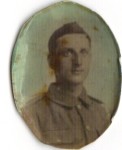
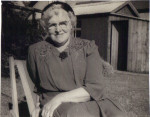 In later years my grandmother was more settled. I remember visiting her in her house in Douglas, which always smelt of China tea – something she was particularly fond of. She had a poodle called Chico who was a terror to all who came near him. I also remember that she had a constant wheeze (which I now realise was probably from her years in Manchester). She was a worrier, but could also be quite fun, and I remember sitting next to her at the dinner table at Aunt Dorothy’s and her digging me in the ribs and giggling at some risque joke. Despite all the difficulties of her life and all her worries, she was always able to laugh and have a bit of fun. Nanna died in 1980 in a nursing home in Douglas, Isle of Man.
In later years my grandmother was more settled. I remember visiting her in her house in Douglas, which always smelt of China tea – something she was particularly fond of. She had a poodle called Chico who was a terror to all who came near him. I also remember that she had a constant wheeze (which I now realise was probably from her years in Manchester). She was a worrier, but could also be quite fun, and I remember sitting next to her at the dinner table at Aunt Dorothy’s and her digging me in the ribs and giggling at some risque joke. Despite all the difficulties of her life and all her worries, she was always able to laugh and have a bit of fun. Nanna died in 1980 in a nursing home in Douglas, Isle of Man.
